汶川地震桥梁易损性分析研究
- 格式:pdf
- 大小:374.44 KB
- 文档页数:10


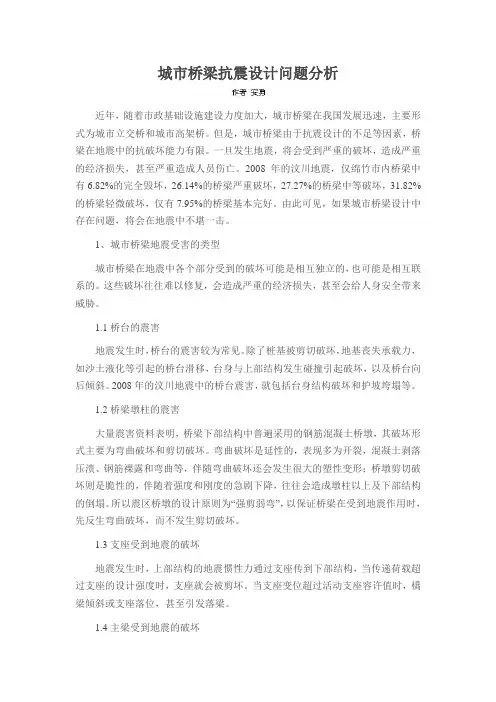
城市桥梁抗震设计问题分析近年,随着市政基础设施建设力度加大,城市桥梁在我国发展迅速,主要形式为城市立交桥和城市高架桥。
但是,城市桥梁由于抗震设计的不足等因素,桥梁在地震中的抗破坏能力有限。
一旦发生地震,将会受到严重的破坏,造成严重的经济损失,甚至严重造成人员伤亡。
2008年的汶川地震,仅绵竹市内桥梁中有6.82%的完全毁坏,26.14%的桥梁严重破坏,27.27%的桥梁中等破坏,31.82%的桥梁轻微破坏,仅有7.95%的桥梁基本完好。
由此可见,如果城市桥梁设计中存在问题,将会在地震中不堪一击。
1、城市桥梁地震受害的类型城市桥梁在地震中各个部分受到的破坏可能是相互独立的,也可能是相互联系的。
这些破坏往往难以修复,会造成严重的经济损失,甚至会给人身安全带来威胁。
1.1桥台的震害地震发生时,桥台的震害较为常见。
除了桩基被剪切破坏,地基丧失承载力,如沙土液化等引起的桥台滑移,台身与上部结构发生碰撞引起破坏,以及桥台向后倾斜。
2008年的汶川地震中的桥台震害,就包括台身结构破坏和护坡垮塌等。
1.2桥梁墩柱的震害大量震害资料表明,桥梁下部结构中普遍采用的钢筋混凝土桥墩,其破坏形式主要为弯曲破坏和剪切破坏。
弯曲破坏是延性的,表现多为开裂,混凝土剥落压溃、钢筋裸露和弯曲等,伴随弯曲破坏还会发生很大的塑性变形;桥墩剪切破坏则是脆性的,伴随着强度和刚度的急剧下降,往往会造成墩柱以上及下部结构的倒塌。
所以震区桥墩的设计原则为“强剪弱弯”,以保证桥梁在受到地震作用时,先反生弯曲破坏,而不发生剪切破坏。
1.3支座受到地震的破坏地震发生时,上部结构的地震惯性力通过支座传到下部结构,当传递荷载超过支座的设计强度时,支座就会被剪坏。
当支座变位超过活动支座容许值时,橋梁倾斜或支座落位,甚至引发落梁。
1.4主梁受到地震的破坏主梁在地震中的震害主要为主梁的纵向移位、横向移位及扭转移位,如果主梁的移位超出了墩、台的支承面,则会发生落梁震害;另外,主梁还可能发生碰撞震害。
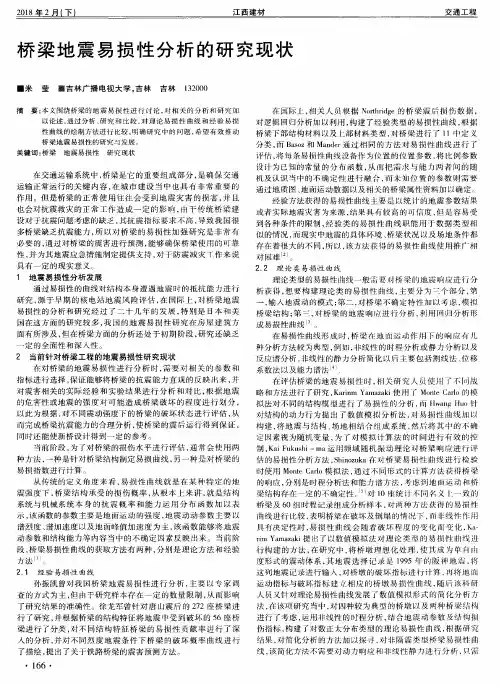
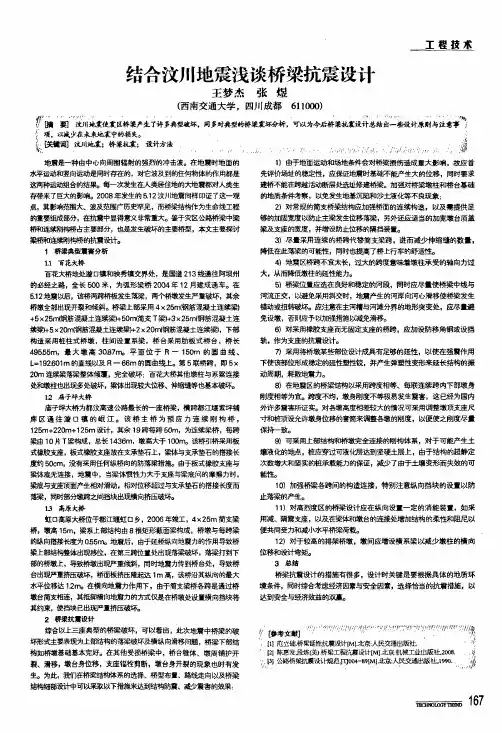
结合汶川地震浅谈桥梁抗震设计工程技术王梦杰张煜(西南交通大学,四川成都611000)矿晶‘南…‘玉I量震使叠矗舞梁产量÷许多羹型磁譬不,同多对典型的桥梁震坏分祈,可以为今后舞桑巍叠鑫并基毒};;二二墓≤鼻悸南乌≤≤÷90}项,以减少在未来地震中的损失。
铰【荚篷词】,砌’l地震;桥梁抗震;设计方法地震是一种由中心向周围辐射的强烈的冲击波。
在地震时地面的水平运动和竖向运动是同时存在的,对它波及到的任何物体的作用都是这两种运动组合的结果。
每一次发生在人类居住地的大地震都对人类生存带来了巨大的影响。
2008年发生的5_12汶川地震同样印证了这一观点,其影响范围大、波及范围广历史罕见,而桥梁结构作为生命线工程的重要组成部分,在抗震中显得意义非常重大。
鉴于灾区公路桥梁中梁桥和连续刚构桥占主要部分,也是发生破坏的主要桥型,本文主要探讨梁桥和连续网9构桥的抗震设计。
1桥梁典型震害分析1.1百花大桥百花大桥地处漩口镇和映秀镇交界处,是国道213线通往阿坝州的必经之路,全长500米,为弧形梁桥20Q4年12月建成通车。
在5.12地震以后,该桥两跨桥板发生落梁,两个桥墩发生严重破坏,其余桥墩全部出现开裂和倾斜。
桥梁上部采用4x25m(钢筋混凝土连续翊+5x25m(钢筋混凝土连续梁卜50m(简支T梁¨3x25m(钢筋混凝土连续粱h5×20m(钢筋混凝土连续粱卜2X20nY钢筋混凝土连续梁),下部构造采用桩柱式桥墩,柱间设置系梁,桥台采用肋板式桥台,桥长495.55m,最大墩高3087m。
平面位于R一150m的圆曲线、L=192.601m的直线以及R一66m的圆曲线上。
第5联桥跨,即5x 20m连续梁落梁整体倾覆,完全破坏:百花大桥其他墩柱与系粱连接处租帧娃弛出现多处破坏,粱体出现较大位移、伸缩缝等也基本破坏。
12庙子坪大桥庙子坪大桥为都汶高速公路最长的一座桥梁,横跨都江堰紫坪铺库区通往漩口镇的岷江。

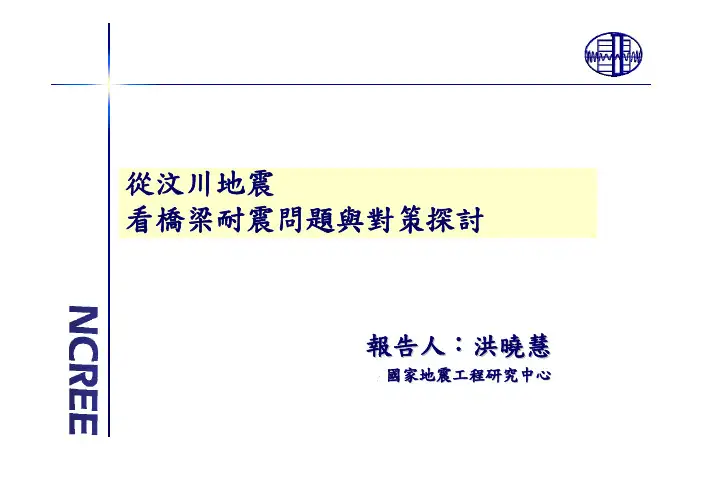
從汶川地震看橋梁耐震問題與對策探討報告人:洪曉慧國家地震工程研究中心內容大綱汶川地震橋梁破壞情形–百花大橋–廟子坪岷江大橋–小漁洞大橋–其他國道213公路沿線橋梁–市區高架橋汶川地震橋梁破壞模式與耐震問題初步探討汶川地震橋梁破壞情形公路交通災情概要根據中國交通運輸部之統計數據顯示,截至6月6日,汶川地震已造成四川、甘肅、陜西、重慶、雲南、湖北等省市受損高速公路19條,國省幹線155條,農村公路4569條,損毁公路里程33370公里,橋梁4840座,隧道98座,損失金額達615.15億元人民幣空拍圖白花鄉百花大橋05.28爆破翻攝自成都早報震害爆破破壞上部結構橫向位移彭州市小漁洞大橋四跨鋼筋混凝土拱橋,跨越白水河 通往龍門山銀廠溝風景區的惟一通道圖片來源:中國西部知青網圖片來源:中國西部知青網第一跨第二跨第三、四跨第三跨映秀鎮附近的橋市區高架橋成都市區高架橋都江堰市區高架橋棉竹市區高架橋汶川地震橋梁破壞模式初步探討橋梁破壞模式防落長度不足,且無防落措施,造成落橋。
上部結構位移過大,造成橋梁結構間之撞擊與橋面擠壓造成落差。
橋台受擠壓坍陷變形。
橋柱撓曲強度及韌性不足,容易產生脆性破壞。
接頭鋼筋不足,且構造設計細節未盡理想,造成接頭之破壞。
不恰當之主筋鋼筋中斷與搭接,形成橋墩弱面。
曲線橋彎扭耦合效應與支承拉拔力造成之上部結構扭轉破壞,支承鬆脫並落橋。
破壞原因初步探討汶川地震規模高於其規範設計需求–根據中國國家地震局,本次地震最大烈度達11度。
–四川災區抗震設防烈度多為7度中國現行橋梁耐震設計規範老舊「公路工程抗震設計規範」(JTJ004-89)–1989正式發行(民國78年)–無地震效應之組合–耐震設計細節無具體規定如主筋搭接,箍筋配置及防落裝置等均無具體規定–未將近年來地震工學新知識的累積和世界各地強烈地震震害經驗納入考量。
重建因應對策建議上部結構–改建為重量輕之鋼結構連續橋梁,以有效降低上部結構靜載重,減少地震慣性力,降低下部結構彎矩需求。

桥梁抗震问题分析研究摘要:在过去的这些年中,地震带来的灾害不言而喻,地震中交通中断直接影响了一切工作的正常进行,更大化的扩大了灾害的损失,使得人民的财产和安全受到巨大危机。
这对人类带来的不只是巨大的代价,更多惨痛的教训,不断警示世人对于桥梁抗震问题需高度重视。
本文叙述了桥梁抗震理论中的分析方法、当今抗震行列的现状以及对于桥梁抗震问题的一些控制措施等,并对于我国抗震前沿的展望提出了期待。
关键词:桥梁抗震研究分析1. 引言在我国过去的这些年里,发生了多次重大地震,给人民带来了不小的灾难。
例如:1966 年,河北邢台大地震;1970 年,云南省通海地震;1973 年,炉霍发生地震;1975 年海城地震以及1976 年唐山发生的大地震中交通运输受到了严重损害,唐山地震中这表现的更为严重更为明显。
76年唐山大地震震级7.8 级,震中位于唐山市区的东南部位,震源在地面下11km处。
在这次地震中,桥梁的破坏情况十分严重。
桥梁是交通的咽喉,地震发生后,交通阻塞,在去往唐山市区实施救助的道路上,交通彻底瘫痪,使得物资和救援极大受阻,以至于人员伤亡惨重。
唐山大地震是中国桥梁抗震史上的一个转折点,从此以后,我国对于桥梁的抗震提出的高度的重视,不仅于此,在以后的建设中,对于抗震问题也提出了更高的要求。
2. 国内外桥梁抗震研究现状1971年,美国San Fernando 发生大地震,此后,美国学者就地震对结构的影响进行研究和探索,研发出了一系列关于地震反应对于建筑结构设计的计算方法,其中包括:反应谱法,时程分析法、随机震动法等等地震反应的计算研究方法。
日本是多地震国家,对于地震的研究有较为前沿的作为,日本在简直梁体系上做了大量的减隔震技术,采取高阻尼支座实现对于桥梁的减震效应。
我国对于工程结构抗震研究起步较晚,但是进展的很快。
以唐山大地震为转折点,在之后历次地震震害之后,于1989 年颁布了《公路工程抗震设计规范》,2008 年在汶川地震后又颁布了《公路桥梁抗震设计细则》,并且提出“两水平设防、两阶段设计”的抗震设防标准,而且对于延性的设计、位移设计、能力保护设计以及减隔震等设计都提出了十分明确的计算方法和构造规定。
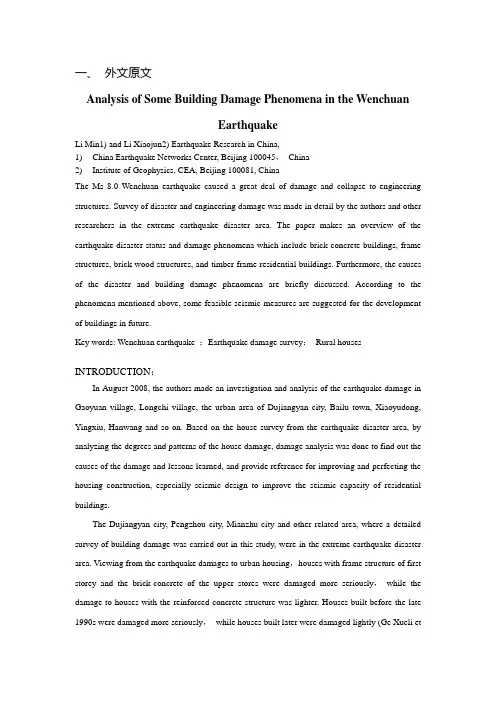
一、外文原文Analysis of Some Building Damage Phenomena in the WenchuanEarthquakeLi Min1) and Li Xiaojun2) Earthquake Research in China,1) China Earthquake Networks Center, Beijing 100045,China2) Institute of Geophysics, CEA, Beijing 100081, ChinaThe Ms 8.0 Wenchuan earthquake caused a great deal of damage and collapse to engineering structures. Survey of disaster and engineering damage was made in detail by the authors and other researchers in the extreme earthquake disaster area. The paper makes an overview of the earthquake disaster status and damage phenomena which include brick-concrete buildings, frame structures, brick-wood structures, and timber frame residential buildings. Furthermore, the causes of the disaster and building damage phenomena are briefly discussed. According to the phenomena mentioned above, some feasible seismic measures are suggested for the development of buildings in future.Key words: Wenchuan earthquake ;Earthquake damage survey;Rural housesINTRODUCTION:In August 2008, the authors made an investigation and analysis of the earthquake damage in Gaoyuan village, Longchi village, the urban area of Dujiangyan city, Bailu town, Xiaoyudong, Yingxiu, Hanwang and so on. Based on the house survey from the earthquake disaster area, by analyzing the degrees and patterns of the house damage, damage analysis was done to find out the causes of the damage and lessons learned, and provide reference for improving and perfecting the housing construction, especially seismic design to improve the seismic capacity of residential buildings.The Dujiangyan city, Pengzhou city, Mianzhu city and other related area, where a detailed survey of building damage was carried out in this study, were in the extreme earthquake disaster area. Viewing from the earthquake damages to urban housing,houses with frame structure of first storey and the brick-concrete of the upper stores were damaged more seriously,while the damage to houses with the reinforced concrete structure was lighter. Houses built before the late 1990s were damaged more seriously,while houses built later were damaged lightly (Ge Xueli etal., 2008). In addition,houses designed in strict accordance with the requirement of seismic design code for buildings and through the seismic reinforcement before the earthquake (such as adding structural columns,ring beams,etc.),had good seismic performance. When earthquake occurs,the dislocation of the fault often occurs in hundreds of millimeters to several meters in horizontal or vertical direction,which directly causes serious damage to foundation and structure of the buildings across or adjacent to the fault. At the same time,strong ground motion near the fault caused by a sudden dislocation of the fault can also lead to serious damage to nearby buildings. One phenomenon in this earthquake was that most severely damaged areas were near the fault,which demonstrates the seriousness of damage on the earthquake fault and the area nearby once again. Therefore the engineering site should avoid active faults as far as possible.In this paper,we use seismic damage survey data of houses from seriously damaged areas to analyze the seismic damage of ordinary residential buildings in urban area and self-built housing and public buildings in rural area,and discussed the causes of the significant differences of damage patterns and degrees on the building structures.1 ANALYSIS OF FIELD SURVEY DATA OF SEISMICALLY DAMAGED BUILDINGS1.1 Urban Commercial and Residential BuildingsMost of houses along the streets in Dujiangyan downtown were 5 〜6 storey brick-concrete buildings. Usually the first storey was with the frame structure. Prefabricated panels were widely used for floors and roofs,and the wall thickness was usually 240mm. Many of these houses were moderately or severely damaged,or even partly collapsed in the earthquake. Generally,the first and second floors were most seriously damaged,and the degrees of damage decreased with the increase of floor number. Patterns of housing destruction were:damage to the plastic hinges at the capitals or the end of columns on the first floor; X-shaped cracks,inclined cracks or horizontal cracks on spine wall of the first and second floors,serious cross-cracks on walls under windows (Sun Jingjiang,et al.,2008 ; Zhang Minzheng,2008).Most of houses in new residential areas in Dujiangyan city were 5 or 6-storey,brick-concrete or frame structures built after 2001. Most of these houses were largely intact or slightly damaged. Observed from the facade,little cracking phenomena were found on the outer vertical walls and gables. Horizontal cracks or peeling plaster layer were seen at a few entrancesof buildings. Cracks were commonly found on stairwell treads. This may be related with the retention of construction joints. Mostly slight cracks could be seen in inner longitudinal and transversal bearing walls on the first two floors while those on other floors remained largely intact.In the heavily damaged zone of Hanwang,Deyang city, brick-concrete residential building with ring beam and constructional columns near fault surface rupture zone collapsed completely . On the contrary, several 6-storey brick-concrete residential buildings located in an area of serious damage and collapse of houses suffered from significantly less damage with only X-shape cracks on walls under windows. These brick-concrete houses adopted more reasonable anti-seismic measures with proper setting of ring-beams, constructional columns and etc.1.2 Rural Residential BuildingsThe main source of income of Gaoyuan village was tourism,residential houses there were mostly built as holiday villages or rural households hotels. Some of them were built around 2006, some were renovated from old houses, and some were under the construction and remained self-finished invested. Overall, most of the houses in the village were seriously damaged by the earthquake. The structural types of the houses in the village can be divided into brick-concrete,frame, brick-wood and wood architecture. Most brick-concrete houses were two-storey ones. Most of floors were prefabricated panels. Most of houses of this type were seriously damaged, even partially or completely collapses, but there were also slightly damaged houses which were built in recent years. The frame structure houses were commonly built recently. However,compared with the semi-finished works under construction,the damage were relatively slighter,but difficult to repair and reinforce. However,a just-built frame structure tea-house in the village remained intact,even the window glass was not broken, and only the side wall was slightly damaged. Brick-wood houses were 1 〜2 storey ones, mainly hard purlin roofs, with roofs of small gray tiles or asbestos. Because of the low mortar strength, poor vertical and horizontal wall connection, usually lack of effective connection between the gable and purlin,seismic damages to this type of houses included damage to spindle tile and wall shear failure, and even the collapse of the walls (Wen Ruizhi, et al., 2008). Wood structure houses had sloping roof with small green tiles. These houses had acceptable seismic performance, and their overall structure remained intact except for the houses with shingle roofing.1.3 Public BuildingsIn the Dongqi technical school located in the seriously damaged area, Hanwang town, the single-story steel-structure workshop remained intact, but the frame structure of teaching building was completely destroyed, the brick-concrete structure of dormitory building with small column distance was slightly damaged (Fig. 10 〜Fig. 12). In the same small area, three buildings with different structures mentioned above suffered seismic damage of different forms. It was clear that the steel structure has the best anti-earthquake performance, but because its high cost, it has not been widely used in China for the general residential building.2 SEVERAL TYPICAL PHENOMENA OF EARTHQUAKE DAMAGEBased on the first-hand information collected from earthquake damaged areas, we analyzed the damage to house structures from aspects of brick-concrete, frame, brick-wood and wood structure residential buildings. Through the discussion on the characteristics of earthquake damage to houses,we summarized several typical earthquake damage phenomena of buildings.2. 1.Destruction at the Sites of Abrupt Change in StiffnessThe houses with high-low structure where the stiffness or strength changed abruptly were more susceptible to damage. The main structure (6-storey frame) of Dongqi Steam-cast Company along the street in Hanwang town was immediately adjacent to a 3-storey commercial and residential building (C&R building,with frame structure for the ground floor and brick-concrete for the upper two floors) . Observing from the side of Dongqi Company,the floors 4 〜6 of the building above the C&R building suffered significantly more serious damage than the lower three floors. This wa s due to “whiplash effect” generated by the earthquake. Locally prominent structures could be easily damaged as large ground motions occurred.2. 2 Destruction of Weak Transition LayerTourist shops along the street were mostly 2 〜3 story buildings,with brick or concrete columns on the ground floor, concrete beams and one brick thick walls above them (some load- bearing walls were only 120mm thick) . In the earthquake, often the bottom was severely damaged, spine wall presented severe cracking or even partial collapse. But in the seriously damaged area in Hanwang town, there was another situation. A single building, which had similar structure with the previous described one, but with half basements, was not damaged much on the bottom floor but its second floor was completely destroyed. In the seismic center Yingxiu town, an uncompleted six-story building with brick-concrete structure lost its entire second floor, the upperfloors 3 〜6 locating directly on the ground floor, and accompanied by reverse phenomenon . These earthquake damages showed that the first two floors of such structures were conversion floors, which were weak and could be broken as a breakthrough, while the construction with even stiffness could resist larger earthquake forces.2.3 Damage to Short ColumnIn the seriously damaged area in Hanwang town, the wall of the ground floor was not filled completely in consideration of ventilation, light and other factors, resulting in the short column effect of frame-column between two walls ( determined by whether the shear span ratio was small than or equal to 2 ) . As is known, the ductility of short columns was poor and prone to shear failure when suffered from earthquake of the seismic fortification. In this case the formation of the artificial short column inadvertently became seismic weak part of the whole structure. The short columns were crushed after the cut, causing severe structural damage.3 CONCLUSIONSBased on the field survey information in seriously damaged regions of Wenchuan earthquake,we showed typical earthquake damages to ordinary residential houses in cities,self-built houses in villages and towns, and public buildings. We also analyzed causes of various or even striking different patterns and degrees of damages to structure of buildings. For the purpose of tourism and economic development,large open rooms were needed for buildings along the urban streets for business. In some large communities,the bottom two floors were often used as gymnasium,restaurant and other public places. Therefore,such buildings usually adopted frame structure for the bottom part, while brick-concrete structure for the upper floors to meet the requirement for diversity and flexibility of room sizes. This kind of structural type change caused serious disaster in this earthquake. Thus, requirements for seismic resistance of such building structures should be emphasized, and reasonable solutions to the contradiction between the requirement for big space and the implementation of seismic measures (such as shear wall) are in need. For self-built housing by rural villagers, the main notion is that a house should not adopt the load-bearing structures of the combinational use of wooden, brick or reinforced concrete columns. In addition, integrity of houses should also be strengthened. It will have remarkable effect to set reinforced concrete ring beams and constructional columns in brick structure houses for the enhancement of anti-collapse performance.References:Ge Xueli, Huang Shimin, Xue Yantao, et al. Damage analysis and reconstruction suggestions on buildings in Dujiangyan of Wenchuan Ms8. 0 earthquake DO . Earthquake Resistant Engineering and Retrofitting, 2008, 30 (4) : 2 〜11 (in Chinese with English abstract).Sun Jingjiang, Ma Qiang, Shi Hongbin, et al. Building damage in cities and towns located in higher intensity areas during Wenchuan earthquake[ J] . Earthquake Engineering and Engineering Vibration, 2008, 28 (3): 7 〜15 (in Chinese with English abstract).Wen Ruizhi, Wei Jingzhi, Zhao Jisheng, et al. Damage analysis for the buildings in countryside at Wenchuan Ms 8. 0 earthquake and some recovering suggestions [J] . Technology for Earthquake Disaster Prevention, 2008 , 3 (4) : 391 〜397 (in Chinese with English abstract).Zhang Minzheng. Building damage in Dujiangyan during the Ms 8. 0 Wenchuan earthquake [J] . Earthquake Engineering and Engineering Vibration, 2008, 28 (3) : 1 〜6 (in Chinese with English abstract).二、翻译结果汶川地震建筑损坏的分析Li Min1) ,Li Xiaojun2)1) 中国地震台网中心, 北京100045,中国2) 地球物理研究所, CEA, 北京100081, 中国摘要:汶川8.0级地震造成了大量工程结构的破坏和倒塌。
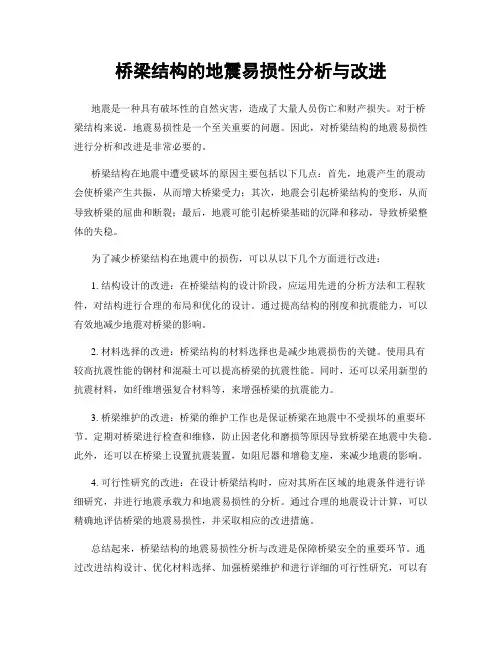
桥梁结构的地震易损性分析与改进地震是一种具有破坏性的自然灾害,造成了大量人员伤亡和财产损失。
对于桥梁结构来说,地震易损性是一个至关重要的问题。
因此,对桥梁结构的地震易损性进行分析和改进是非常必要的。
桥梁结构在地震中遭受破坏的原因主要包括以下几点:首先,地震产生的震动会使桥梁产生共振,从而增大桥梁受力;其次,地震会引起桥梁结构的变形,从而导致桥梁的屈曲和断裂;最后,地震可能引起桥梁基础的沉降和移动,导致桥梁整体的失稳。
为了减少桥梁结构在地震中的损伤,可以从以下几个方面进行改进:1. 结构设计的改进:在桥梁结构的设计阶段,应运用先进的分析方法和工程软件,对结构进行合理的布局和优化的设计。
通过提高结构的刚度和抗震能力,可以有效地减少地震对桥梁的影响。
2. 材料选择的改进:桥梁结构的材料选择也是减少地震损伤的关键。
使用具有较高抗震性能的钢材和混凝土可以提高桥梁的抗震性能。
同时,还可以采用新型的抗震材料,如纤维增强复合材料等,来增强桥梁的抗震能力。
3. 桥梁维护的改进:桥梁的维护工作也是保证桥梁在地震中不受损坏的重要环节。
定期对桥梁进行检查和维修,防止因老化和磨损等原因导致桥梁在地震中失稳。
此外,还可以在桥梁上设置抗震装置,如阻尼器和增稳支座,来减少地震的影响。
4. 可行性研究的改进:在设计桥梁结构时,应对其所在区域的地震条件进行详细研究,并进行地震承载力和地震易损性的分析。
通过合理的地震设计计算,可以精确地评估桥梁的地震易损性,并采取相应的改进措施。
总结起来,桥梁结构的地震易损性分析与改进是保障桥梁安全的重要环节。
通过改进结构设计、优化材料选择、加强桥梁维护和进行详细的可行性研究,可以有效地减少桥梁在地震中的损坏。
这些改进措施不仅能够提高桥梁的抗震能力,还能够保护人民的生命财产安全,为社会的发展做出贡献。
虽然桥梁结构的地震易损性分析与改进是一项复杂的工作,但是随着科技的发展和工程经验的积累,我们相信,在专家学者和工程师们的努力下,桥梁结构的抗震能力一定会不断提高,为人们的出行和交流提供更加安全可靠的保障。

地震破坏下桥梁结构损伤评估与修复技术研究引言:随着地震频发的频率,桥梁常常成为地震灾害中的重点防护对象。
地震引发的强烈震动对桥梁结构造成巨大的冲击,导致桥梁结构出现各种程度的损伤。
为了保障桥梁的安全运行,研究地震破坏下桥梁结构损伤评估与修复技术具有重要意义。
1. 地震破坏下的桥梁结构损伤评估地震引发的震动会导致桥梁结构的各种类型的损伤,包括桥墩的破坏、桥面的断裂、桥梁连接部位的松动等。
损伤的类型和程度对于评估桥梁的安全状况至关重要。
1.1 损伤类型的分类地震破坏下,桥梁的损伤类型可以分为三类:可修复性损伤、局部修复限制损伤和无法修复损伤。
可修复性损伤指的是损伤程度较轻,仅需简单修复,不会影响桥梁的整体结构;局部修复限制损伤是指损伤较为严重,涉及桥梁的关键结构部位,需要有针对性的修复方案;无法修复损伤则是指损伤过重,无法恢复桥梁原有的结构和功能。
1.2 损伤评估的方法桥梁损伤评估是一项复杂而关键的任务,常用的方法包括现场勘察、结构监测和数值模拟等。
现场勘察是最基本和直观的评估方法,通过对损伤结构的实地观察和测量来获取损伤特征和程度。
结构监测则是通过在桥梁上布设各种传感器,实时监测桥梁的震动响应、位移等数据,用于评估结构的健康状况。
数值模拟在桥梁损伤评估中发挥了重要作用。
通过建立桥梁的有限元模型,分析震动荷载对桥梁结构的影响,进而预测损伤的发生位置和程度。
2. 地震破坏下的桥梁结构修复技术当桥梁结构发生损伤后,及时有效地进行修复至关重要,以确保桥梁的安全运行。
2.1 临时抢修技术地震发生后,将桥梁的损伤状况进行初步评估后,通常需要采取临时抢修措施以保障交通的畅通和人员的安全。
临时抢修技术包括临时加固、紧急修复和临时通道的构建等,旨在让桥梁能够暂时恢复使用。
2.2 桥梁结构的终身修复方案除了临时抢修技术外,还需要制定长期的桥梁结构终身修复方案,以保障桥梁的持久安全运行。
终身修复方案的制定需要考虑桥梁的使用年限、修复工艺和材料的选择等。
-----------------------------------Docin Choose -----------------------------------豆 丁 推 荐↓精 品 文 档The Best Literature----------------------------------The Best Literature汶川8.0级地震几座近断层桥梁失效模式的探讨∗周国良1) 李小军1,2)1)中国地震局工程力学研究所,黑龙江哈尔滨 1500802)中国地震局地球物理研究所,北京 100081汶川8.0级地震主要有以下几个特点:震级大、震源浅、强震动持续时间长、波及范围面广、破坏惨重、次生灾害剧烈。
沿发震断层附近的一些大型桥梁,如庙子坪大桥、百花大桥、小渔洞大桥、石蓑衣大桥等破坏尤其严重。
图1 桥址分布与所处地区烈度情况通过对上述几座桥梁震害现场实地考察,得出如下初步结论:(1)地震动强度超出桥梁原设防水平及近断层影响造成上述几座桥梁严重毁坏。
本次地震地震级大(8.0级)、震源浅(10~20 km)、地震动峰值加速度大、强震持续时间过长。
这几座桥梁所在区烈度为Ⅸ~Ⅺ度分布,大大超出原抗震设防水平。
断层错动及近断层地震动方向性效应、长周期速度脉冲效应,使结构产生较大位移和变形,引起桥梁破坏,甚至倒塌。
(2)对于简支梁桥或桥面简易连续梁桥,梁间撞击破坏和落梁是常见的震害现象。
落梁主要是由于上部结构位移过大、邻梁撞击、支座档块约束失效引起。
设置有效的防落梁装置和防撞、减撞装置并增大搭接长度是防止落梁发生的必要措施之一。
对于桥面简易连续梁桥,增大相邻梁的连接刚度可避免落梁或减小可能性。
(3)高烈度区近断层处的不规则高墩曲线桥受力复杂,地震作用下弯、扭耦合效应明显,支座因受拉产生破坏的可能性加大。
采用抗弯扭效应较好的上部主梁结构形式并设置有效的防落梁装置可减轻曲线桥梁震害。
(4)震区地形复杂多变,河谷、群山交错分布,场地土分布复杂,场地效应尤其是场地地形效应明显,桥墩各场点处地震动激励并不一致。
桥梁结构地震易损性分析研究摘要:本文旨在探讨桥梁结构地震易损性分析的研究现状和发展趋势。
通过对文献的综述和实际研究方法的阐述,文章总结了当前桥梁地震易损性分析的成果与不足,并提出了今后研究方向的建议。
研究表明,地震易损性分析在桥梁工程中具有重要意义,提高桥梁的抗震性能和安全性是关键。
引言:地震是一种常见的自然灾害,对人类社会具有极大的破坏力。
桥梁作为交通基础设施,在地震事件中受到的破坏往往会影响到灾区重建和交通恢复。
因此,如何提高桥梁结构的抗震性能和安全性已成为工程界的焦点。
地震易损性分析是一种评估结构在地震作用下可能受到的损伤程度的方法,对于桥梁结构的抗震设计具有重要意义。
文献综述:地震易损性分析方法的发展经历了多个阶段,从最初的基于经验的方法到现代的基于概率论和性能设计的方法。
现有的地震易损性分析方法主要分为三类:基于震害历史的经验方法、基于地震动参数的物理方法、基于结构响应的数值方法。
这些方法各具特点,但在准确性、可靠性和应用范围方面也存在一定的局限性。
研究方法:本文采用了文献综述和案例分析相结合的方法,对桥梁结构地震易损性进行分析。
通过对前人研究的文献进行梳理和评价,总结出各种地震易损性分析方法的优缺点和应用前景。
然后,结合具体案例,对不同方法在实践中的应用进行深入分析,比较其效果和差异。
结果与讨论:通过对文献的综述和案例分析,本文总结了以下三点关于桥梁结构地震易损性分析的研究结果。
现有的地震易损性分析方法在预测桥梁结构在地震作用下的损伤程度方面具有一定准确性,但还需要改进和完善。
不同方法的应用范围和局限性也有所不同,选用何种方法应根据具体情况进行选择。
桥梁的地震易损性与地震动参数、桥型、材料等因素有关,应针对不同情况进行专门研究。
本文通过对桥梁结构地震易损性分析的研究,总结了当前方法的优缺点和应用前景,并提出了今后研究方向的建议。
研究表明,地震易损性分析在桥梁工程中具有重要意义,提高桥梁的抗震性能和安全性是关键。
地震引发公路桥梁破损成因分析地震是由地球内部的地壳运动引起的自然灾害,它可能造成公路桥梁的破损或倒塌。
下面是地震引发公路桥梁破损的成因分析。
首先,地震引发了地壳的剧烈震动和地面的振动。
地震波从震源处向外传播,当地震波经过桥梁时,桥梁会受到震动的影响,导致桥梁结构产生应力。
如果桥梁的结构设计不合理,抗震能力不足,或者桥梁存在一些结构缺陷,比如裂缝、锈蚀等,地震波的震动力很容易导致桥梁的损坏。
其次,地震会引发地质灾害,如地裂缝、滑坡和地面液化等。
地震破坏了地层的稳定性,导致土体发生变形和破坏,进而影响到公路桥梁的稳定性。
例如,地裂缝的出现会导致公路桥梁的支座移位或失稳;滑坡会使桥梁的基础土体移动或被冲刷掉,导致桥梁倾斜或倒塌;地面液化则会使基础土体失去支撑力,导致桥梁沉降或塌陷。
此外,地震会引发桥梁自身结构的动力响应。
地震波的震动力会使桥梁结构进行振动,如果桥梁的振动频率与地震波的频率相近或者相互共振,就会导致桥梁受到更大的力的作用,从而产生破坏。
因此,抗震设计中需要注意桥梁的固有频率和地震波的频率的匹配,以减小桥梁的动态响应。
最后,地震引发的人为因素也可能导致公路桥梁的破损。
地震发生后,人们可能恐慌逃生,导致桥梁承受超过设计荷载的重量,从而引发桥梁破坏。
此外,地震后,救援人员和重型机械设备可能会在桥梁上操作,超重或不合理的操作方法会加剧桥梁的破坏。
综上所述,地震引发的公路桥梁破损的成因主要包括:地震波的震动力作用、地质灾害引发的土体破坏、桥梁自身结构的动力响应以及地震后的人为因素。
为了减小地震对公路桥梁的破坏,需要在桥梁的设计和维修中考虑抗震能力、地质条件和人为因素等多个因素,以提高桥梁的抗震性能。
桥梁震害分析及抗震措施研究张海君【摘要】20世纪我国进入了新的大陆活跃阶段,相比过去地震频率明显增大,其中桥梁作为生命线工程中的关键部分,对地震的作用更为敏感。
为此,对震后桥梁的破坏特征分析研究尤为重要。
结合08年汶川地震,对地震引发的上、下部结构及震后次生灾害引起的桥梁损坏进行了分析,得出了相应的抗震措施的建议,为桥梁抗震设计提供了参考依据。
%In twentieth Century China has entered a new stage,active,compared to the past earthquake fre-quency increased significantly,the bridge as a key part of lifeline engineering,the seismic action more sen-sitive. Therefore, analysis and Research on earthquake damage characteristics of bridge is very important. Combined with 08 years of Wenchuan earthquake, bridge damage to the earthquake that triggered the sub-structure, and post earthquake secondary disasters caused by earthquake are analyzed, the corresponding measure suggestions,provide the reference basis for the seismic design of bridges.【期刊名称】《交通节能与环保》【年(卷),期】2014(000)004【总页数】5页(P64-67,73)【关键词】地震作用;汶川地震;桥梁损伤;抗震措施【作者】张海君【作者单位】山西省交通规划勘察设计院,山西太原 030012【正文语种】中文【中图分类】U442.5+51 概述地震是一种自然现象,全世界每年都会发生很多次地震,其中会造成生命安全和对工程建设产生重大危害的,并且形成灾难的次数达到十几次之多。